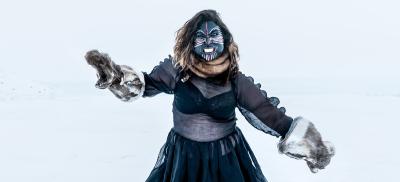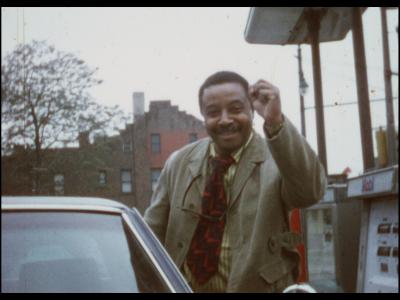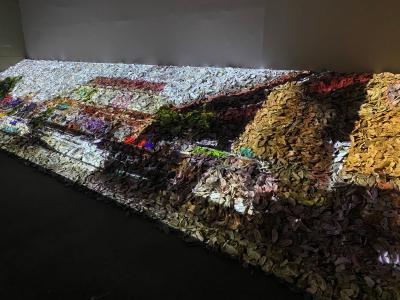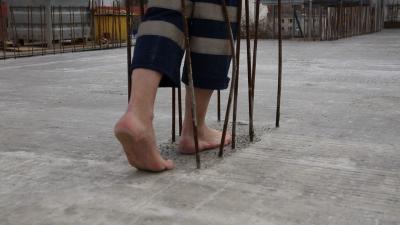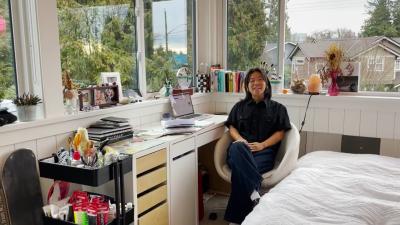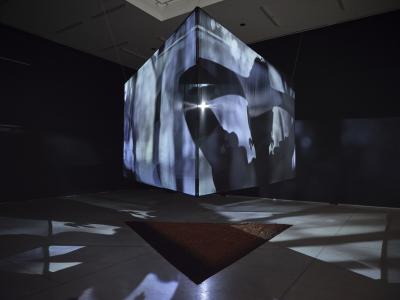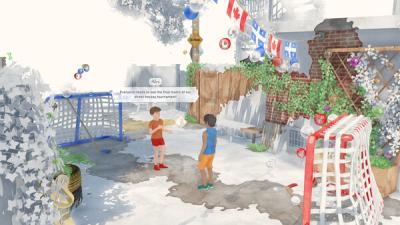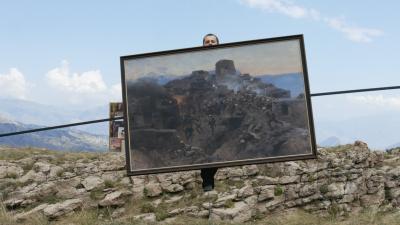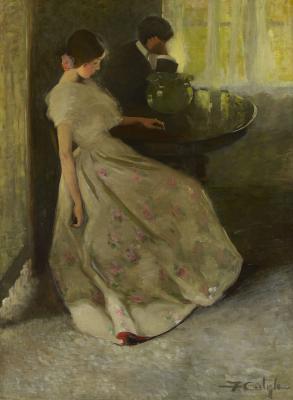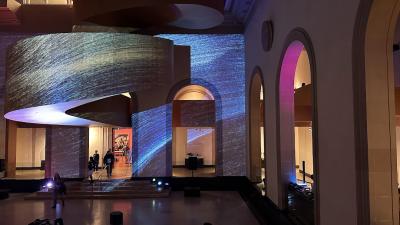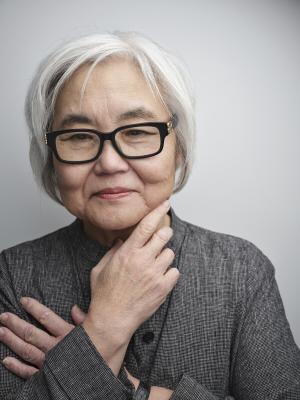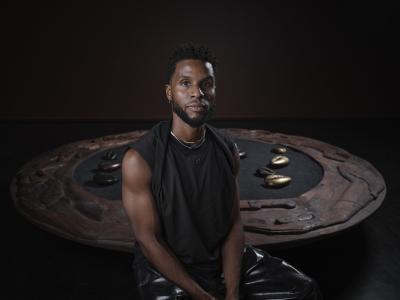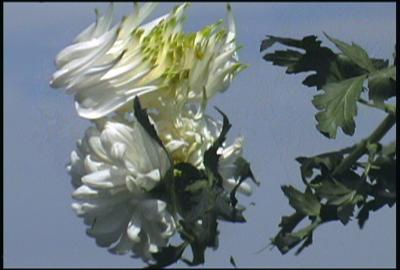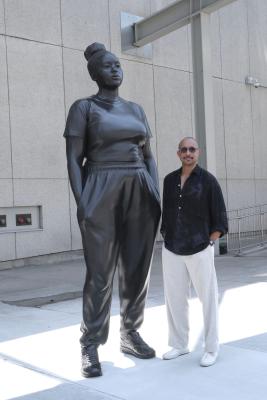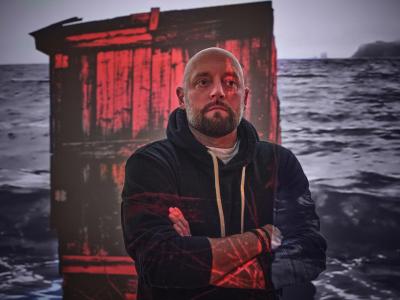Conserving Bright Signs with Claire Molgat Laurin
The AGO’s Time-Based Media Assistant Conservator speaks on preserving video works in the exhibition
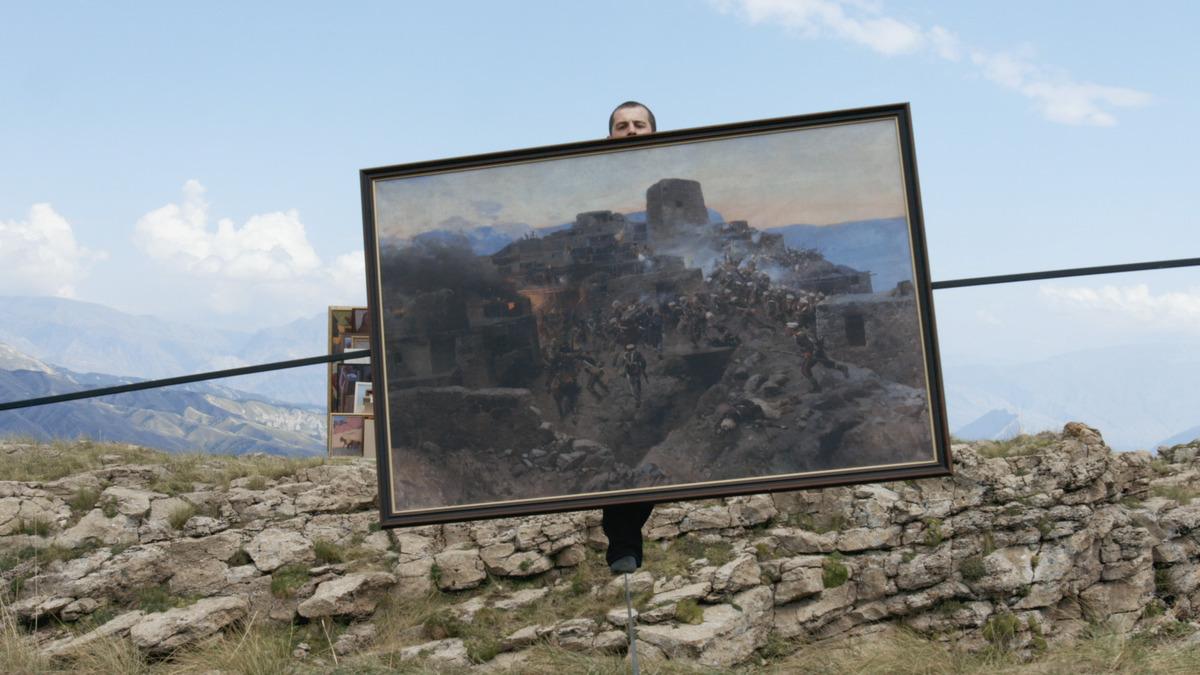
Taus Makhacheva. Tightrope, 2015. HD video, colour, sound, 58.10'. Art Gallery of Ontario. Purchased with the F.P. Wood Fund, 2018. © Taus Makhacheva, courtesy of narrative projects, London. 2017/137
Behind every video work you experience in the exhibition Bright Signs: Spotlight on Video Art is a team of AGO staff tackling the intricacies of making power cords invisible and running 1980s technology in the 21st century.
Part of this team is Claire Molgat Laurin, the AGO’s Assistant Conservator of Time-Based Media, who joined the Gallery in 2023. If you’ve come across a video, sound or light-based work at the AGO in the last year, it’s likely that Molgat Laurin has played a role in ensuring the work could go on view.
On view at the AGO, Bright Signs features cinematic video installations and neon sculptures from 11 leading contemporary artists across three decades, all selected from the AGO Collection. With many works in the exhibition being on view at the AGO for the first time, the exhibition explores critical social issues such as power, visibility, and perceptions of history.
Since Bright Signs is primarily a time-based media exhibition, Foyer sat down with Molgat Laurin to talk about what exactly time-based media is, what this conservation field entails, and what it was like to prepare for the exhibition.

Image courtesy of Claire Molgat Laurin
Foyer: To start, what exactly constitutes time-based media?
Laurin Molgat: Time-based media basically encompasses artworks that progress over time and have change as an intrinsic aspect of the artwork. All artwork has some degree of change eventually, but in the case of time-based media, that degree of change is much more immediate. In practice, that usually ends up encompassing fields like video art and installations, electronic art, and things that have a technological component to them. It involves both digital preservation and conservation of physical objects. In my case, I also often deal with anything that's electrical; if it has a plug, it tends to come to me.
It’s up to me to build a way forward for those works, both in the short-term sense of how we put these works up in the Gallery, and in the long-term sense of how to preserve these works over time. These works often face questions of obsolescence, where the original technology might not be able to remain part of the work. For example, if we have a work running on a CRT monitor from the 90s, those probably won't be around for much longer. So, I ask questions such as, does a work need to be displayed on the original monitor, or can it be displayed on new technology? Depending on answers to questions like this, I try to determine the way forward for each work.
What drew you to time-based media conservation?
It was actually here [at the AGO]. I did a program at Fleming College on general conservation and collections management. While I was there, I ended up doing an internship in the AGO’s Conservation Department ten years ago. Sherry Phillips, who was the AGO’s contemporary conservator at the time, was working on As Yet Untitled (1992-1995) by Max Dean, which is an industrial robot that feeds photos into a shredder unless a viewer interacts with it, which then prompts the robot to put the photo into an archival box. I was supposed to be working on preventative conservation, but I kept looking over her shoulder. She had to work with a programmer that still knew the programming language this robot was running on from the 90s, and with the artist to guide the work that was being done. I found it fascinating how the role brought together and mediated between different skill sets to build a way for a work to continue functioning.
Based off that, I ended up finding a program in contemporary art conservation, since at the time, there weren't really a lot of programs specifically focused on time-based media.
![A still from Lisa Reihana's video work In Pursuit of Venus [Infected]. It is a still of an Indigenous Maori community on an illustrated background of an island](/sites/default/files/styles/max_1300x1300/public/2024-09/AGO.160146-Web%20and%20Standard%20PowerPoint.jpg?itok=nzbTYFCH)
Lisa Reihana. In Pursuit of Venus [infected], 2015-2017. Ultra HD video, colour, 64 mins, Art Gallery of Ontario. Jointly owned by the Art Gallery of Ontario, purchased with funds from the Indigenous and Canadian Committee, funds in memory of Valentine Stock, and funds by exchange from a gift from the J.S. McLean Collection, donated by the Ontario Heritage Foundation. © Lisa Reihana. 2020/94
Bright Signs is primarily a time-based media exhibition. What was the process like preparing works for this exhibition?
I’m so glad the AGO wanted to do an entirely time-based media exhibition. I think with a lot of other artworks, we have to be careful to manage exposure over time. But in the case of time-based media, showing the works is an act of conservation in the sense that you need to think through exactly how it is going to be shown and everything involved. For each work, we had to think about whether the AGO had something we could display it on, if we had a space appropriate for showing these works, and what exactly were the parameters for how these works were going to be shown. In the case of older works, working through these kinds of big questions sooner rather than later is incredibly vital. You don’t know whether you’ll have experts in these kinds of technology still around in five to ten years, or if parts will still be available for the technology the works are running on.
I have to stress how many people’s skills were vital to making these artworks come to life; [preparing for the exhibition] was such a collaborative thing. It took so many people to make sure the exhibition came together. The Installation Team was essential in every aspect, from installing complex multi-channel projections with utmost precision to knowing how we could hang works from the ceiling and where wires could be run through. We worked through the broad-level and nitty-gritty installation details for each work together, with our curator and project manager guiding the process. A lot of my work was to capture the decision-making: what preferences did the artist express about how the work is shown? Are there certain compromises we had to make that could be worked through better in the future? I think one of the most important things I do is capturing what is involved in this iteration of being on view because capturing the result doesn’t encompass all the conversations had during this process. It’s all part of a cumulative process of building a work’s history and identity within the context of where it’s being preserved.
Some works in Bright Signs were created recently while some have been in the AGO Collection for decades. How do time-based conservators keep up with modern technology while maintaining the original intention of older works?
This is the essential question of time-based conservation — trying to define the degree of change that can occur, depending on the needs of that work, and honouring the artist’s intention. If you have a painting, for example, the general philosophy towards the conservation of these works is to try and keep to original materials as much as possible and to not intervene where it's not necessary. This does hold true for time-based media works as well, but the allowable degree of change is perhaps a little bit wider since you are trying to preserve an overall experience of an artwork.
I think it’s such a case-by-case basis. For example, Jenny Holzer’s studio was open to having Selections from UNDER A ROCK (You create an incident...) (1986) refabricated in the future so that it's still able to display the text programming, even if it requires using newer technology. But at the same time, that 80s LED technology [used in the original work] is interesting and significant to the context in which it was originally made – it’s a lot more massive and it has a bigger physical presence than what you would find today. There are interesting aspects that would be different if it was run on different technology. For example, [the '80s LED sign] hums and when there are more LED lights on, the hum gets more intense.
Another interesting example is Ian Baxter&’s TVs in Television Works (around 1999-2006) because that work would be tricky to adapt to other technology. He painted directly onto the CRT monitor screens and you can see the [technology creating the static behind the paintings] is getting a little shaky. These monitors aren’t going to last forever, and I’m glad we’re showing them now. When the CRT monitors do die, it’s going to be complicated because the screen is like a large bulb, so you can’t separate the screen from the interior without endangering what’s been painted on the screen. I’ll need to converse with Ian Baxter& and see if we should explore options when the screens eventually die, or if he feels this will be the end of the work. We’d like things to last as long as possible, but if that’s counter to an artist’s wishes or if it goes against the spirit of the work, there must be the option to accept the end of the work.
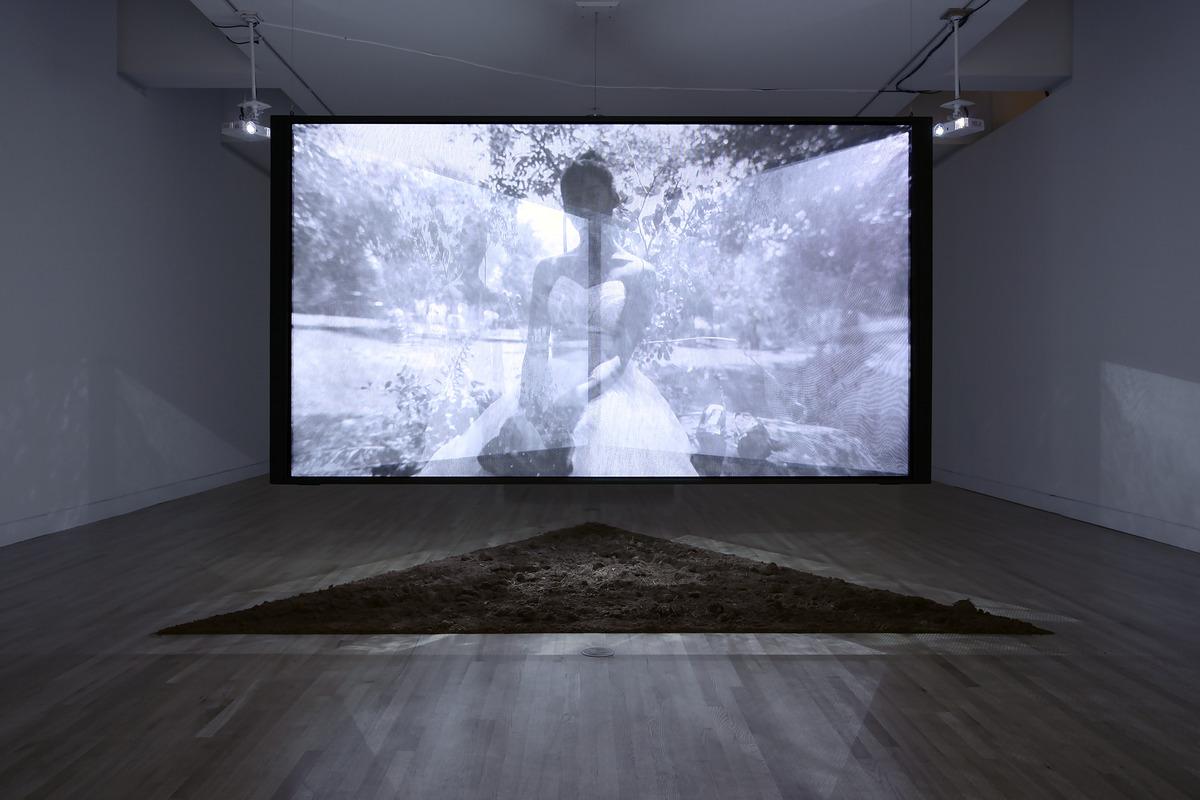
Kahlil Joseph, Wildcat (Aunt Janet), 2016. Three-channel video installation with dirt from Grayson, Oklahoma rodeo, black and white HD video, Running Time: 7 Minutes, 53 Seconds. Art Gallery of Ontario. Purchase, with funds from the Modern and Contemporary Curatorial Committee, 2021. © Kahlil Joseph. Installation view. 2020/144
What are some of your favourite works that you helped prepare for Bright Signs?
The fact that all the works come from the AGO Collection, and the fact that there's such a wide range of works from different time periods made the exhibition especially cool to work on. I really enjoyed simultaneously working on works from the '80s, early 2000s, and works that have just come into the Collection like Kahlil Joseph’s Wildcat (Aunt Janet) (2016).
Wildcat hasn’t been on view since it was acquired, so having the opportunity to work through installation questions with that work was interesting. We had examples from previous viewings of the work, so we had a bit of an idea of what we were dealing with. At the same time, the way this work manifested in the space was completely different than what I expected. For example, I think I had completely underestimated the extent to which Wildcat is very much a light-based work and not just a video work. The way the video plays on the walls of the space and the way it transmits through different layers of the screen felt much more pronounced than I expected.
Seeing Wildcat come to life was gratifying and a massive team effort. Greg Baszun [the AGO’s Senior Media Technician] did all the installation work for the media, the Installation Team made the screens and installed the dirt, and there were so many questions we had to work through. Seeing it installed now, there’s a bunch of things I’m already thinking about adjusting for the next iteration, such as working on the screens more and increasing light transmission on them.
I think it’s absolutely wonderful how Wildcat came to life [in Bright Signs] but as a [time-based conservator], you’re already looking at the next possibility and what we can learn from this installation to pass on for the next showing.
Appreciate the behind-the-scenes work of Claire Molgat Laurin and the AGO’s Installation Team firsthand by visiting Bright Signs: Spotlight on Video Art, currently on view until October 14 on Level 4 of the AGO. This exhibition is curated by Debbie Johnsen, Manager, Modern and Contemporary Collections and features artworks that will form the cornerstone for the expansion of the new Dani Reiss Modern and Contemporary Gallery, starting construction in 2024.
